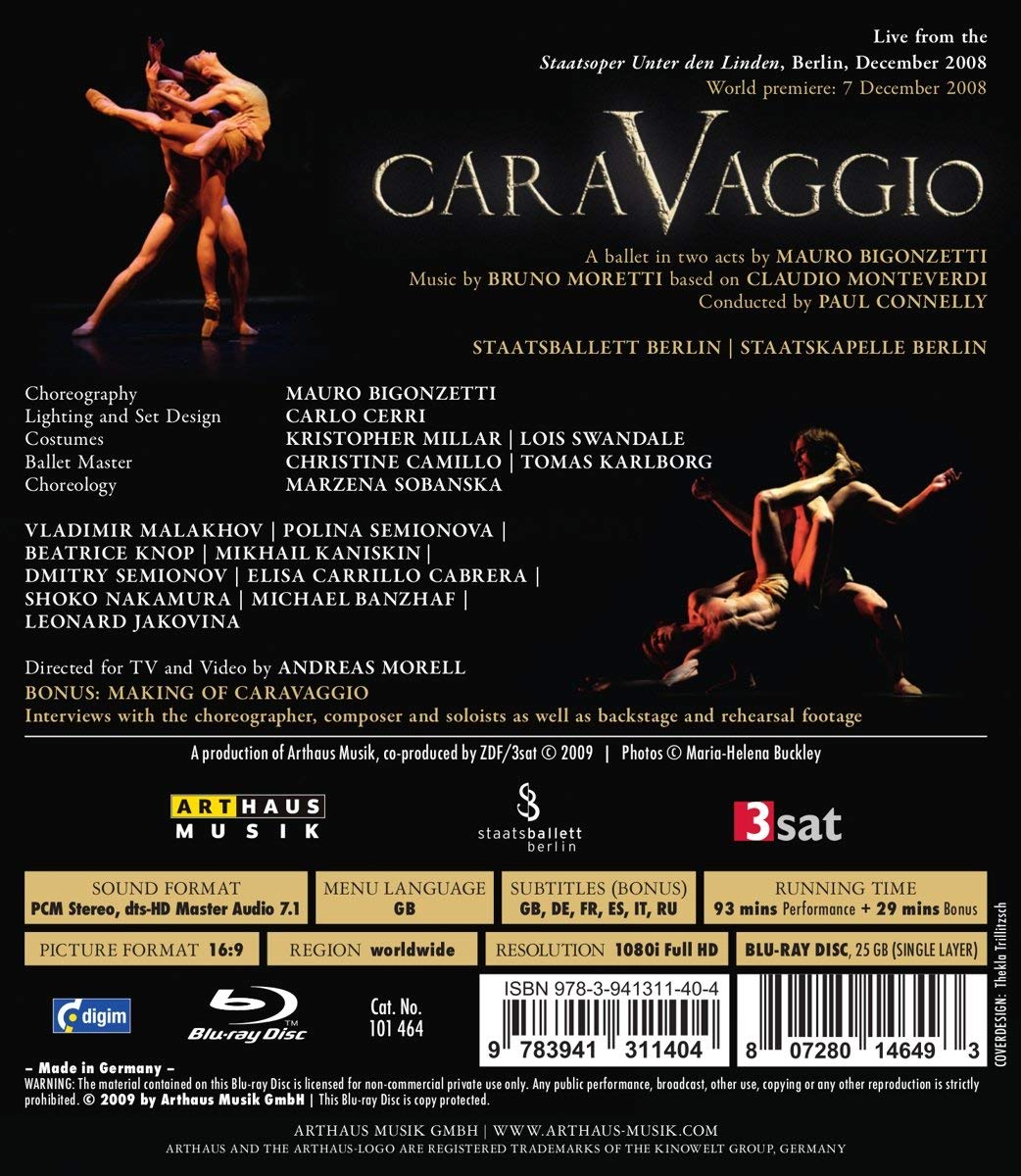

Caravaggio modern ballet choreographed by Mauro Bigonzetti. Music by Bruno Moretti based on numerous selections from Claudio Monteverdi. Performed 2008 by the Berliner Stattsballett at the Staatsoper Unter den Linden. Stars Vladimer Malakhov, Polina Semionova, Beatrice Knop, Mikhail Kaniskin, Dmitry Semionov, Elisa Carrillo Cabrera, Shoko Nakamura, Michael Banzhaf, and Leonard Jakovina. Additional dances are Sarah Mestrovic, Stephanie Greenwald, Sebnem Gülseker, Marina Kanno, Krasina Pavlova, Nanami Terai, Xenia Wiest, Arshak Ghalumyan, Dominic Hodal, Alexander Korn, Vladislav Marinov, Federico Spallitta, Robert Wohlert, Mehmet Yümak, Iana Balova, Maria Baumpouli, Soraya Bruno, Maria Giambona, Elinor Jagodnik, Enelyn Kocak, Anastasia Kukova, Natalia Munoz, Aoi Suyama, Verena Thurm, Martin Arroyos, Gevorg Asoyan, Giacomo Bevilacqua, Taras Bilenko, Christian Krehl, Aymeric Mosselmans, Alexej Orlenco, Javier Pena Vazquez, Kévin Pouzou, Alexander Shpak, and David Simic. Paul Connelly conducts the Staatskapelle Berlin. Lighting and set design by Carlo Cerri; costumes by Kristopher Millar and Lois Swandale; choreology Marzena Sobanska (not a typo---choreology is a form of dance notation). Directed for TV by Andreas Morell. Released 2009, disc has 7.1 dts-HD Master Audio sound. Grade: B+
I recently saw about 12 Caravaggio paintings along with many similar works in a show called, "Caravaggio and his School." In those days, the art market was to paint for churches and royalty. So most of Caravaggio's work was intensely religious. But he was also a reprobate, and he liked to paint card sharks, grinning Bacchus figures, severed heads, and the like. So that's why Act 1 is about bawdy street-life in Italy and Act 2 is about martyrdom.
There's nothing biographical about this ballet, but it does treat many themes that appear in Caravaggio's paintings. At a deeper level, Mauro Bigonzetti creates images in his choreography that have obvious similarities to Caravaggio's painting style, which often involved heavy use of black background and shadows intersecting with vivid, realistic depictions of people under terrific psychological and/or physical stress. To help create a dance that looks like a living Caravaggio painting, Bigonzetti drew on the lighting and design skills of Carlo Cerri. And Bigonzetti also had the good fortune to get videographer Andrea Morell on board. Morell, who has a number of excellent HDVD shoots to his credit and recently outdid himself in serving as TV Director for the Alonzo King Lines Ballet disc, is the best in the business at making video of the human body in motion.
The Berliner Stattsballett assembled a fine group of splendid dancers for this production. The music composed by Bruno Moretti is exceptionally beautiful and danceable. And Bigonzetti was right there as guest choreographer drilling everybody to perfection. Up to this point, I would say the result would have to be an A or A+ title.
But there is a problem with the book. This is supposed to be an abstract ballet. But there are just enough specific bits of information and unusual actions to suggest that there is a story going on. The main character is called "Caravaggio," there is an important female part for "The Light," and another lead female dancer seems to be dangerous, etc. Then there's the "Calling of Saint Matthew," who appears to be the same person as Caravaggio (who was not a saint). And when it comes time for martydom, we see the martyr slashing away at most of the other characters.
The ballet doesn't make sense, and nobody has to my knowledge been able to explain it. That's a shame because this title is full of some of the most beautiful people and dancing that has ever been recorded. In the screenshots below, I will give you at least one image of each of the 9 credited star dancers. The "names" I use for the various roles are ideas I picked up off the Internet from others who have written about this work. But because this is not a "story" ballet, the images may be presented out of performance order.
This is Vladimir Malakhov, Artistic Director of the Berliner Stattsballett and the lead star in this production. Here is taking the role of Caravaggio himself (per the program notes):
The female lead is the Russian Polina Semionova, dancing the role of "The Light":
Three shots of Malakhov and Semionova:
This is an abstract ballet. But doesn't this shot demand that you ask the question, "What on earth are these people looking at?"
Some say Beatrice Knop represents the "dark force."
Here we see Knop and Leonard Jakovina in two shots. The eye sockets in total shadow was a typical Caravaggio trick:
Here's Shoko Nakamura and Mikhail Kaniskin portraying, per J. Faulk (on Amazon.com) the "True Lovers."
The male athletes shown here are Mikhail Kaniskin and Dmitry Semionov (Polina's brother). I don't know which one is which:
The last credited star is Elisa Carrilo Cabrera as the fortune teller, a famous Caravaggio subject, shown reading a palm:
There are also a fair number of fun shots of the corps---this was a young company:
Morell wasn't afraid to use his camera in the fly space:
This is the beginning of the an especially beautiful dance by the True Lovers:
But now the true lovers admit Caravaggio to the tryst:
Ménage à trois?
This shot (which was used with the disc artwork) really does look like a Caravaggio painting:
And here's a bit of homoeroticism:
At the end of Act 2 we have the Martyrdom scene, which looks to me like some kind of civil-war atrocity:
To sum up, this work is challenging and rewarding to watch if you like modern ballet. Had Bigonzetti figured out a comprehensible libretto, it could have been a great hit. Maybe one day he will make some revisions to make the work more accessable. Still, even though the libretto is difficult, this title has been popular. Under our grading system, I had this as a B. But thanks to its popularity, I move the grade up to B+.
OR


























